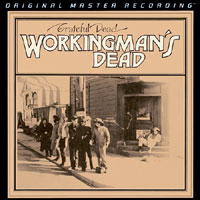Grateful Dead • Workingman's Dead
Grateful Dead • American Beauty
n a couple of weeks, over the Fourth of July weekend, the surviving members of the Grateful Dead -- guitarist Bob Weir, bassist Phil Lesh and drummers Mickey Hart and Bill Kreutzmann -- will reunite for a three-night extravaganza at Chicago's Soldier Field. They will musically commemorate the band's final concert together, which occurred almost twenty years earlier to the day, also at Solider Field. Trey Anastasio of Phish will take the place of the late Jerry Garcia -- about as apropos an understudy as could be imagined. Bruce Hornsby will play piano. This is how we have come to know the Dead -- as a larger-than-life phenomenon fueled by their sprawling live performances, so many of which were singular events. Yet, in the late 1960s, when the band formed and released its first albums, none of this was planned or remotely anticipated. The Dead's freeform experimentalism was born, but it was with 1970's Workingman's Dead and American Beauty that the band established a musical foundation in the loose playing and tight vocal harmonies of folk, country and roots rock. There are points during which both albums sound at once like the work of Crosby, Stills, Nash & Young then Basement Tapes-era Dylan, quite a feat for a rock band that established itself as the most improvisational of its day. Perhaps because of the devolution of popular music in the new century, these songs sound almost as fresh today as they did 45 years ago. American Beauty was recorded just a few months after Workingman's Dead. While it explored the same musical terrain, it established themes that would come to define the band -- from the free-love take on the "My love is like a red, red rose" conceit on "Sugar Magnolia" to nomadic "Truckin'" for its own sake. It is on American Beauty that mandolin master David Grisman made his Dead debut, beginning a long musical friendship with Jerry Garcia. While neither Workingman's Dead nor American Beauty is a sonic spectacular in its own right, the gentle, nuanced playing is well served by clear, unagressive sound. There is more inner detail and texture, more clarity and verisimilitude, on these MoFi reissues than on early original pressings, which sound thinner and grainier by comparison. The SACDs sound more like very good analog than mere digital, but the immediacy of the 45rpm LPs is startling, even after hearing the SACDs. Just listen to "Casey Jones," one of the few Dead songs that was a staple of FM radio, and you'll hear what I'm talking about. Jerry Garcia's vocal is much more vivid and present. There must be a committee choosing titles for Mobile
Fidelity to reissue, so diverse and unpredictable are the choices. One month we get Miles
Davis and Bob Dylan, the next Hall & Oates, Foreigner and Weezer. With these Grateful
Dead titles, MoFi has reintroduced and reestablished a pair of gems for a generation of
younger listeners. If what you know of the Dead are the secondhand clichés -- the drugs,
the epic jams, the hippie freedom -- these two albums will reveal what all of the fuss was
really about. |


